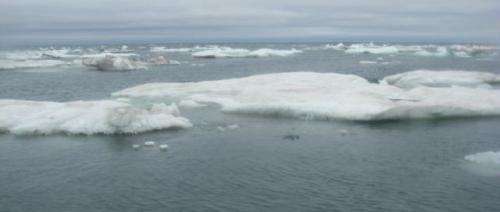New discovery in Arctic is a very old clam

The rapidly thawing Arctic Ocean may be a new frontier but some of the latest news from there concerns a clam that is believed to date back more than a million years.
Some bivalves retrieved from the ocean depths during a 2010 mapping mission in the Beaufort Sea turn out to be members of a species previously unknown to science, according to a study published in the journal ZooKeys.
Scientists from the U.S. Geological Survey, who were exploring the area aboard a Coast Guard icebreaking cutter, found the clam shells in a core sample dug with a 4-inch-diameter pipe into the seafloor.
The shells were found in the seafloor in water nearly 1.5 miles deep.
Once the shells were extricated from the Arctic Ocean sediment, a process accomplished at the USGS lab in Menlo Park, Calif., scientists could see that they were different from all other known species.
"I certainly didn't know what they were," said Paul Valentich-Scott, curator of malacology at the Santa Barbara Museum of Natural History, a mollusk expert recruited by the USGS geologists to be the lead author of the newly published study. "I definitely knew it wasn't anything I had seen before."
The clams, though small, were far bigger than others found far out in the Beaufort Sea - a couple of centimeters across instead of a couple of millimeters, Valentich-Scott said. They had a far rounder shape than others found in the general region, and maintained a thick brown skin, known as a periostracum, that was unlike the much thinner skin found on other clams, he said.
About 20 shells or shell fragments were found in sediments ranging from less than an inch below the seafloor to about 15 feet below.
Geologists, not biologists, conducted the mapping mission that resulted in the clams' discovery, but they could tell that the shells were unusual, Valentich-Scott said.
"The chief scientist (Brian Edwards) recognized that there were some special animals out there," he said.
That realization got Valentich-Scott involved in the project to identify the clams, work that included a comparison with known species documented as far away as Japan, New Zealand and Britain.
It turns out that this Beaufort Sea clam is not only a new species, but also a new genus, or category of species.
The genus is now named Wallerconcha, in honor of Thomas Waller, a paleontologist at the Smithsonian Institution. The new species name is Wallerconcha sarae, in honor of co-author Charles Powell's daughter Sara.
Just how long the newly discovered clams lived in the region is unclear.
The site was a conical underwater formation known as the Canning Seafloor Mound, which rises about 590 feet high and stretches nearly 4,000 feet across. It is more than 90 miles off the coast of the Arctic National Wildlife Refuge. The expedition that made the discovery was a joint U.S.-Canada Beaufort Sea mapping mission, with scientists aboard both the Healy and a Canadian Coast Guard icebreaker, the Louis S. St-Laurent.
The most deeply buried samples were in sediment that, based on fossils it contained, was 1.8 million years old, Valentich-Scott said. But other samples closer to the seafloor surface were in far newer sediment, indicating that the clam may not be extinct.
The 1.8 million-year figure is considered "the oldest possible age it could be," said Powell, a USGS research geologist. "Most likely, it's been there for over a million years," he said.
Live versions of the clams might even be somewhere near the samples collected in 2010, possibly right on the same sea mound but missed during the core sampling, he said. Unlike near-shore areas of the Arctic that have been transformed as sea levels rose and fell over past millennia, the habitat of this clam has not changed much, he said.
"It's been pretty steady," he said. "It's dark and cold."
©2014 Alaska Dispatch News (Anchorage, Alaska)
Distributed by Tribune Content Agency, LLC


















